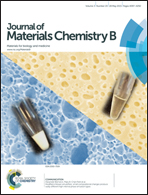Nano-silver in situ hybridized collagen scaffolds for regeneration of infected full-thickness burn skin†
Abstract
Nano hybrid materials have attracted extensive attention in the biomedical field. However, it is still a challenge to make biofunctional nanoparticles homogenously distributed in 3D scaffolds. In this research, histidine (His) was covalently cross-linked into collagen (Coll) scaffolds and the imidazole derived from His was employed as a template to chelate silver ions which were then reduced in situ to form silver nanoparticle (Ag NP)–hybridized Coll scaffolds. The resultant nanocomposite demonstrated an increased mechanical strength and the Ag NPs showed a narrow size distribution and were dispersed homogeneously in the 3D Coll/His scaffolds. Moreover, these hybrid scaffolds exhibited better biocompatibility and antibacterial properties against both Gram positive and Gram negative bacteria than Coll scaffolds. The Coll/His/Ag NPs scaffolds were transplanted to the infected full-thickness burn skin of the SD rat model; the results revealed excellent regeneration effects after three weeks compared with the groups not treated with Ag NPs. This study has offered a facile method to construct functional nanoparticle hybridized scaffolds for efficiently healing infected wounds.


 Please wait while we load your content...
Please wait while we load your content...